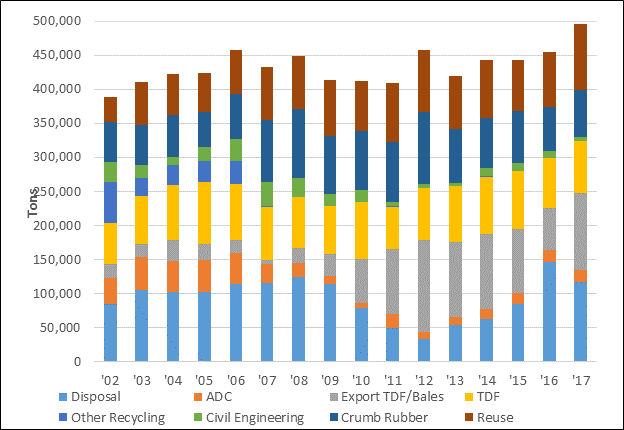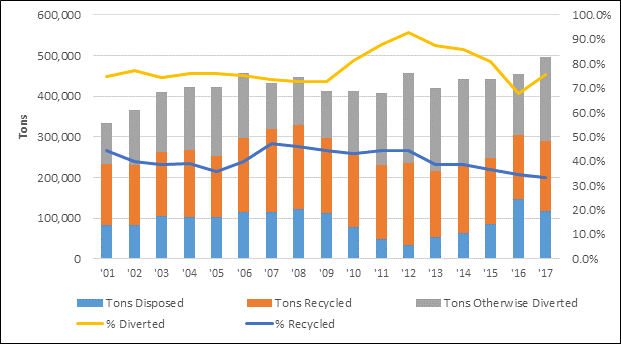Tire Management Overview
California has more registered vehicles than any other state. As a result, more than 51 million reusable and waste tires are generated each year.
CalRecycle is dedicated to finding new uses for this valuable resource and working with local governments, industries, and the public towards reaching this goal.
What happens to reusable and waste tires?
CalRecycle estimates that of the approximately 51.1 million reusable and waste tires generated in 2018, approximately 42.1 million of the tires were diverted through various alternatives, including reuse, retreading, and combustion.
The recycling rate (excludes alternative daily cover and tire-derived fuel) increased from 33.3% in 2017 to 36.6% in 2018.
The recycling markets in California do not consume all of the waste tires generated. Waste tires need to be stored safely until sufficient markets are in place to increase the consumption of waste tires.
CalRecycle provides the proper waste tire management framework by enforcing waste tire facility and waste tire hauler regulations.
Fifteen-Year Trend for California Waste Tire End-Uses in Tons 1
The below chart is from the California Tire Market Report: 2018.

How is CalRecycle meeting the challenge of reducing the landfill disposal of waste tires?
CalRecycle has developed and funded a variety of waste tire management activities to achieve, including:
- Business development assistance to California enterprises.
- Research to expand the uses and recyclability of tires.
- Assistance to local governments to manage waste tires.
- Regulation of waste tire facilities and waste tire haulers to help ensure the protection of public health, safety, and the environment.
- Public education.
Waste Tire Diversion and Disposal Trends in Tons

How is CalRecycle’s tire program funded?
The California Tire Recycling Act of 1989 authorized the creation of the Tire Recycling Program and the California Tire Recycling Management Fund. A fee is assessed on the sale of new tires, and collected revenue is deposited quarterly into the tire fund. CalRecycle allocates funds annually based on availability and changing program needs.
See the California Department of Tax and Fee’s fact sheet, California Tire Fee for more information.
How is the program structured?
California’s waste tire management and recycling efforts are divided into two functional areas:
- Tire permitting and enforcement activities
- Tire recycling and market development activities
The tire permitting and enforcement activities ensure that reusable and waste tires are stored and transported safely. CalRecycle coordinates with local and regional agencies to mitigate unsafe situations at existing abandoned tire pile sites and provide technical assistance.
Tire recycling activities include offering financial assistance, engaging in recycling and marketing research, and providing technical assistance.
Five Year Plan
The Five-Year Plan for the Waste Tire Recycling Management Program establishes goals and priorities for the waste tire recycling program and includes programmatic and fiscal issues as well as performance objectives and measurement criteria. This plan is updated every two years.
For more information contact: Tire Management Program Hotline, WasteTires@calrecycle.ca.gov or (866)-896-0600.
